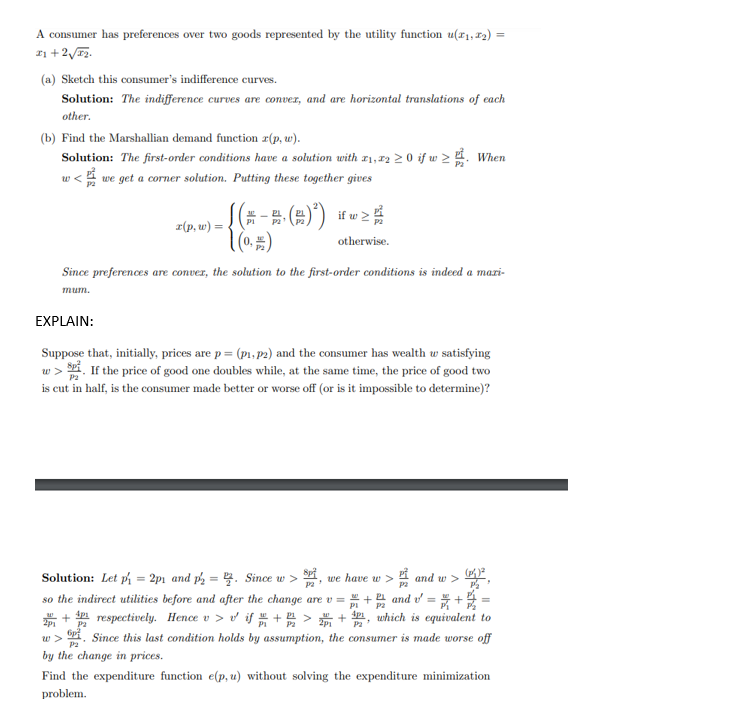A consumer has preferences over two goods represented by the utility function (₁,₂)= 21 +2√/72. (a) Sketch this consumer's indifference curves. Solution: The indifference curves are conver, and are horizontal translations of each other. (b) Find the Marshallian demand function z(p, w). Solution: The first-order conditions have a solution with 21, 22 ≥ 0 if w≥. When w< we get a corner solution. Putting these together gives z(p, w) = 201 ((5 - -· (ª)²³) if w≥ ª 1 (0.) otherwise. Since preferences are conver, the solution to the first-order conditions is indeed a maxi- mum. EXPLAIN: Suppose that, initially, prices are p = (p₁.p2) and the consumer has wealth w satisfying w>. If the price of good one doubles while, at the same time, the price of good two is cut in half, is the consumer made better or worse off (or is it impossible to determine)? Solution: Let p₁ = 2p₁ and p = . Since w > we have w > and w> so the indirect utilities before and after the change are v = =+ + and = **+ 2 = respectively. Hence v> ✓ if + B > 2 +, which is equivalent to w>. Since this last condition holds by assumption, the consumer is made worse off by the change in prices. Find the expenditure function e(p, u) without solving the expenditure minimization problem. + 421 Pa
A consumer has preferences over two goods represented by the utility function (₁,₂)= 21 +2√/72. (a) Sketch this consumer's indifference curves. Solution: The indifference curves are conver, and are horizontal translations of each other. (b) Find the Marshallian demand function z(p, w). Solution: The first-order conditions have a solution with 21, 22 ≥ 0 if w≥. When w< we get a corner solution. Putting these together gives z(p, w) = 201 ((5 - -· (ª)²³) if w≥ ª 1 (0.) otherwise. Since preferences are conver, the solution to the first-order conditions is indeed a maxi- mum. EXPLAIN: Suppose that, initially, prices are p = (p₁.p2) and the consumer has wealth w satisfying w>. If the price of good one doubles while, at the same time, the price of good two is cut in half, is the consumer made better or worse off (or is it impossible to determine)? Solution: Let p₁ = 2p₁ and p = . Since w > we have w > and w> so the indirect utilities before and after the change are v = =+ + and = **+ 2 = respectively. Hence v> ✓ if + B > 2 +, which is equivalent to w>. Since this last condition holds by assumption, the consumer is made worse off by the change in prices. Find the expenditure function e(p, u) without solving the expenditure minimization problem. + 421 Pa
Chapter4: Utility Maximization And Choice
Section: Chapter Questions
Problem 4.11P
Related questions
Question
please teach explain step by step

Transcribed Image Text:A consumer has preferences over two goods represented by the utility function u(x₁, x2) =
21+2√3₂.
(a) Sketch this consumer's indifference curves.
Solution: The indifference curves are conver, and are horizontal translations of each
other.
(b) Find the Marshallian demand function z(p, w).
Solution: The first-order conditions have a solution with x1, x2 ≥ 0 if w≥. When
we get a corner solution. Putting these together gives
x(p, w) =
if
((-- -· (2) ²) iu≥ #
1 (0, #)
otherwise.
Since preferences are conver, the solution to the first-order conditions is indeed a mazi-
mum.
EXPLAIN:
Suppose that, initially, prices are p = (p₁, p2) and the consumer has wealth w satisfying
w>. If the price of good one doubles while, at the same time, the price of good two
is cut in half, is the consumer made better or worse off (or is it impossible to determine)?
and w>
P2
so the indirect utilities before and after the change are v = = + 2² and v² = ₁ + 2/2 =
P2
Solution: Let p₁ = 2p₁ and p2=2. Since w > SP² we have w >
"
W + respectively. Hence v > v if + 2 > 201 + 1, which is equivalent to
2p1 P2
6p²
w>
P2
by the change in prices.
Find the expenditure function e(p, u) without solving the expenditure minimization
problem.
Since this last condition holds by assumption, the consumer is made worse off
Expert Solution
This question has been solved!
Explore an expertly crafted, step-by-step solution for a thorough understanding of key concepts.
Step by step
Solved in 2 steps with 1 images

Knowledge Booster
Learn more about
Need a deep-dive on the concept behind this application? Look no further. Learn more about this topic, economics and related others by exploring similar questions and additional content below.Recommended textbooks for you







Microeconomics: Principles & Policy
Economics
ISBN:
9781337794992
Author:
William J. Baumol, Alan S. Blinder, John L. Solow
Publisher:
Cengage Learning